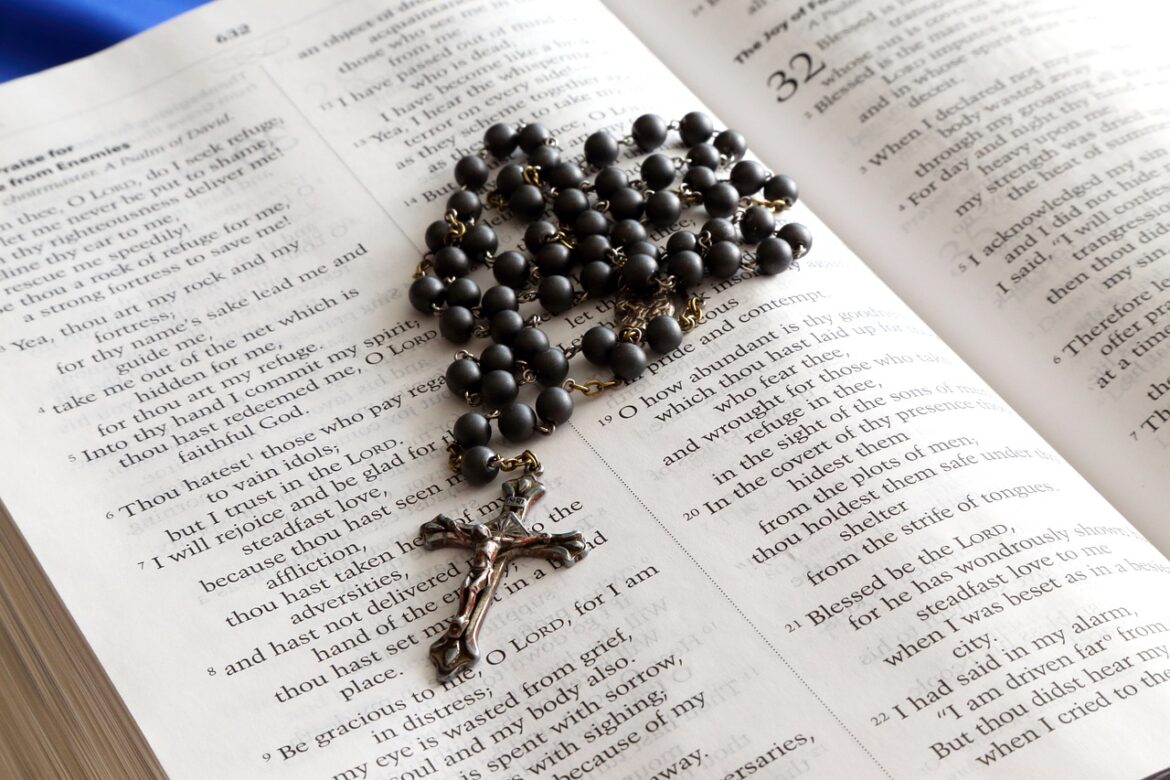Working on this project and others that I have, I realized that quoting the Bible for these projects is important. I wanted to quote it properly and accurately, and I wanted to make sure that I didn’t violate any copyright laws.
At first, I thought that the Bible is for everyone to use and that if I see religious books, prayer books, or merchandise (such as t-shirts, cards, or art with phrases from the Bible), it means that it is Copyright-free. This turns out not always the case.
Does the Bible have Copyright?
The Bible is a library, a set of books whose original texts are in the public domain and can of course, be used freely. However, the original texts are found in Hebrew and Aramaic (Old Testament) and Greek (New Testament).
Even Latin translations such as the Latin Vulgate are in the public domain and can also be used freely. The problem is that very few of us nowadays are fluent in Hebrew, Aramaic, Greek and /or Latin.
Modern translations have copyrights, and this is because they did the hard work of translating these texts, while trying to be faithful to the original texts. Because of this, they cannot be used freely.
Most of the current versions have restrictions like the following one that we can observe in Bible Gateway:
LA BIBLIA DE LAS AMÉRICAS (LBLA)
Publisher: Lockman
Copyright Information
Permission To Quote
The text of La Biblia de las Americas® may be quoted and/or reprinted up to and inclusive of five hundred (500) verses without express written permission of The Lockman Foundation, providing the verses do not amount to a complete book of the Bible nor do the verses quoted account for more than 25% of the total work in which they are quoted.
Notice of copyright must appear on the title or copyright page of the work as follows:
“Scripture taken from LA BIBLIA DE LAS AMERICAS®, Copyright © 1986, 1995, 1997 by The Lockman Foundation. Used by permission.”
Quotations and/or reprints in excess of the above limitations, or other permission requests, must be submitted online or directed to and approved in writing by The Lockman Foundation, PO Box 2279, La Habra, CA 90631, (714)879-3055.
What is Public Domain?
While this gives us some flexibility to use our favorite version, some prefer to avoid any problems, or to have more flexibility, and therefore look for a public domain version.
According to Wikipedia the public domain of a work:
Consists of all the creative work to which no exclusive intellectual property rights apply. Those rights may have expired, been forfeited. Because those rights have expired, anyone can legally use or reference this works without permission.
In the USA the Copyright laws are the following:
The copyright law of the United States grants monopoly protection for original works of authorship. With the stated purpose to promote art and culture, copyright law assigns a set of exclusive rights to authors: to make and sell copies of their works, to create derivative works, and to perform or display their works publicly.
These exclusive rights are subject to a time limit, and generally expire 70 years after the author’s death or 95 years after publication. In the United States, works published before January 1, 1927, are in the public domain.
What versions of the Bible are in the Public Domain?
Investigating which versions of the Bible are in the public domain, the easiest thing to find everywhere are the oldest versions of the King James Version-KJV in English and the Reina Valera-RVA in Spanish.
The main drawback I have with these two versions is that they are incomplete because they are Protestant versions and do not have the Deuterocanonical books, often misnamed as the Apocrypha.
The Deuterocanonical books are one of the main differences between the Catholic and Protestant Bibles. The Deuterocanonical books are as follows:
Tobias, Judith, Baruch, Ecclesiasticus, Wisdom, 1 Maccabees and 2 Maccabees, as well as some additions to the books of Esther and Daniel.
This required more research on my part, and in English, we can find only one Catholic Church-approved version of the Bible.

Catholic Versions of the Bible translated into English and Church-approved in the Public Domain
In English we only find:
DOUAY-RHEIMS 1899 AMERICAN EDITION (DRA) This is the Catholic Bible in English par excellence and the one I will highly recommend.
Complete versions of the Bible not approved by the Catholic Church.
The Catholic Public Domain Version of the Holy Bible (CPDV) This version was made particularly to be in the public domain.
According to the website where it can be found, is a translation of the Sacred Bible, Sixtus V, and Clement VIII Latin Vulgate edition.
Three different versions of the Latin Bible were used for this translation: the 1861 edition edited by C. Vercellone, the 1885 edition published by Desclee, and the 1914 edition edited by M. Hetzenauer.
A public domain edition of the Challoner Douay-Rheims Version of the Bible was used as a guide in translating the Latin Bible into English.
The sole translator and editor of the Catholic Public Domain Version is Ronald L. Conte Jr. The CPDV has no copyright, trademark, or other legal restrictions, and no one may copyright this version of the Bible.
All this is very promising because faithful and ancient texts were used for this translation.
World English Bible Catholic Edition (WEBC) This version was also made to be in the public domain. According to its website, The World English Bible (WEB) is a modern translation of the Holy Bible in English in the Public Domain (without copyright).
That means it can be freely copied in any form, including electronic and printed formats. It is based on the American Standard Version of the Holy Bible first published in 1901, the Old Testament Stuttgart Hebrew Bible, and the Greek Majority Text of the New Testament.
The Deuterocanonical books are derived from the Revised Version and Brenton’s translation of the Septuagint into English. It is in draft form and is currently being edited for accuracy and readability. The books of the Old and New Testaments are essentially finished, although some proofreading comments are still accepted.
The problem I have with these last two versions (CPDV y WEBC) is that they do not have an imprimatur .
In the Catholic Church, an imprimatur is an official declaration by a Church authority that a book or other printed work may be published; it is usually only applied for and granted to books on religious topics from a Catholic perspective. Approval is given following canons 822 to 832 of the Code of Canon Law, which do not require the use of the word “imprimatur”.
These versions don’t have ecclesiastical approval, and therefore, have not obtained official recognition as a Catholic version of Sacred Scripture.
Canon 825 of the Roman Catholic Code of Canon Law states:
§1. The books of the holy Scriptures cannot be published without the approval of the Apostolic See or the Episcopal Conference. For the publication of their translations into the vernacular, it is also required that they be approved by the same authority and provided with the necessary and sufficient annotations. (1)
The DOUAY RHEIMS version meets this requirement.
Catholic Versions of the Bible translated to Spanish in the Public Domain
In Spanish, the public domain versions are:
Biblia Torres Amat 1825 (BTA). This is a very popular version in Spanish, Catholic par excellence, translated directly from the Latin Vulgate.
Biblia Felipe Scio de San Miguel Catholic version of the Bible in Spanish, translated from the Latin Vulgate. On this page, we can find the 4 gospels online.
Complete versions of the Bible not approved by the Catholic Church.
Biblia del oso (BDO1573) Translation published in 1569 by Casiodoro de Reina, a Spanish religious convert to Protestantism, therefore this translation is not approved by the Catholic Church, however it has the Deuterocanonical books.
It is the first translation of the complete Bible in Spanish based on manuscripts in Hebrew and Greek. Previous translations of the complete Bible into Spanish, such as the pre-Alphonsine Bible and the Alphonsine were translated from Latin texts.
La Santa Biblia libre para el mundo (SBLM) This is the Spanish version of the WEBC. As I said earlier, it is still in the process of revision and does not have authorization from any Ecclesial authority.
I hope this article is helpful to you. Of course, there is also the option of
buying the Douay-Rheims and Torres Amat versions in digital and
physical forms.
About the autor

Ele V
Ele is a devout Christian who loves to learn and share about the beauty of the Catholic Faith.
Popular Posts
Donate! Give me a Coffe!



